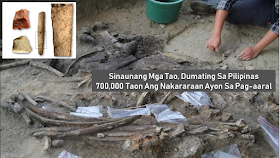Early humans roaming east Asia more than half-a-million years ago may be appear to be clever enough to build a vessel and curiously cross an open sea to be able to reach the Philippines.
It may seem evident from the discovery in the Philippines of a rhinoceros skeleton and the stone tools probably used to carve away its meat, according researchers.
It may seem evident from the discovery in the Philippines of a rhinoceros skeleton and the stone tools probably used to carve away its meat, according researchers.
Ads
The discovery pushes back the arrival of the first homo species on the island chain ten-fold to 700,000 years ago,as reported in the journal Nature.
Earlier archaeological clues from Luzon island -- tools at one site, prehistoric animals remains at another --suggestive of the presence of primitive human species, indicating Homo-erectus and Homo floresiensis probably populated the Indonesian archipelago during the same period.
But to date, the earliest confirmed evidence of hominins -- the scientific term used to group modern and early humans -- in the Philippines came from a, 67,000-year old foot bone unearthed in the Sierra Madre Mountains.
"We had the extraordinary luck to find a nearly complete, disarticulated rhinoceros," said Thomas Ingicco, a paleoanthropologist at France's National Museum of Natural History and lead author of the study.
Analysis of the bones from the extinct species -- Rhinoceros Philippinensis -- left no doubt "that it showed ridges left by tools," Ingicco added.
Some of the cut marks were made while removing flesh, while others came from specialized tools designed to remove bone marrow.
Ingicco and his colleagues also uncovered the skeletal remains of other potentially tasty critters, including brown deer, monitor lizards, freshwater turtles and stegodons, extinct mammals combining elephant and mammoth features.
Rhino carpaccio
"We know that some species of human ate this rhino," said Ingicco. "But we don't know if they killed if first, or found the carcass."
All told, the Kalinga site in northern Luzon's Cagayan Valley yielded more than 400 bones and several dozen of ancient tools, including 49 knife-like flakes and two hammers.
"This evidence pushes back the proven period of colonialization of the Philippines by hundreds of thousands of years," the authors concluded.
Several dating techniques applies to the rhino remains determined its age at between 631,000 and 777,000 years, putting it in a period known as the Pleistocene.
With no direct trace of the humans who butchered the animals, researchers could only speculate on who they were and how they got there.
It is also possible that the butchers of Kalinga had already evolved into a distinct sub-species, as likely happened to the "hobbit" of Flores, diminutive humans named for the Indonesian island where they were first found.
As for how "Kalinga Man" made it across what is today 1,000 kilometers (620 miles) of open ocean between Luzon and mainland Asia, the authors doubt they fashioned a raft or other sea-worthy vessel.
"The colonialization could have happened 'accidentally' after a tsunami ripped up the coastline and created a temporary land bridge, a rare but documented phenomenon," said Ingicco.
Ads
©2019 THOUGHTSKOTO


